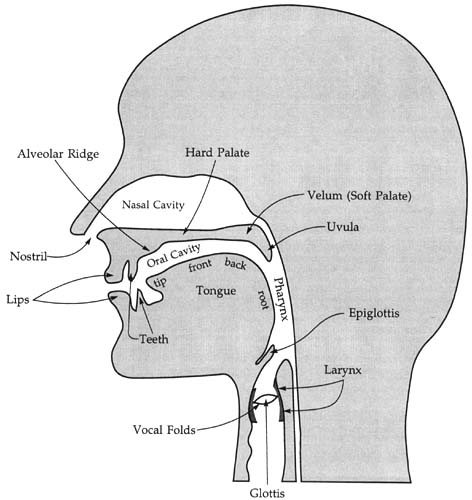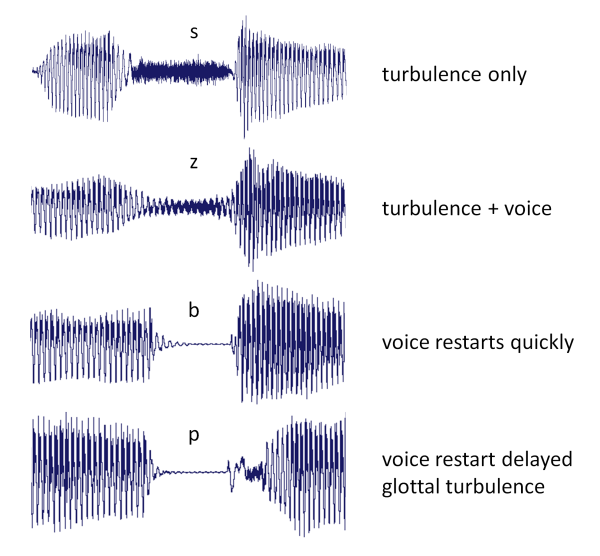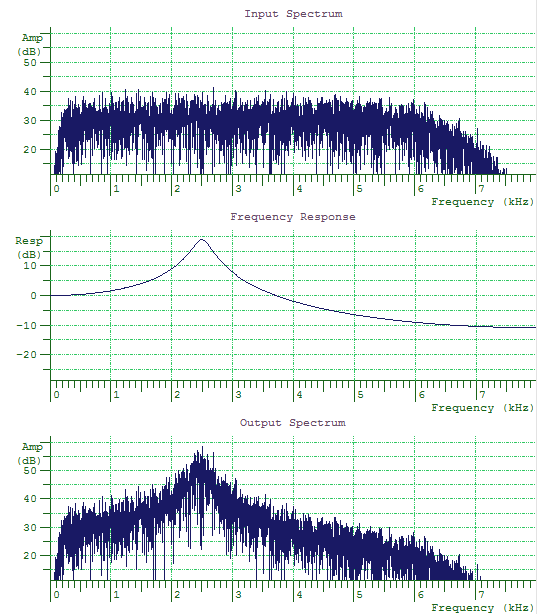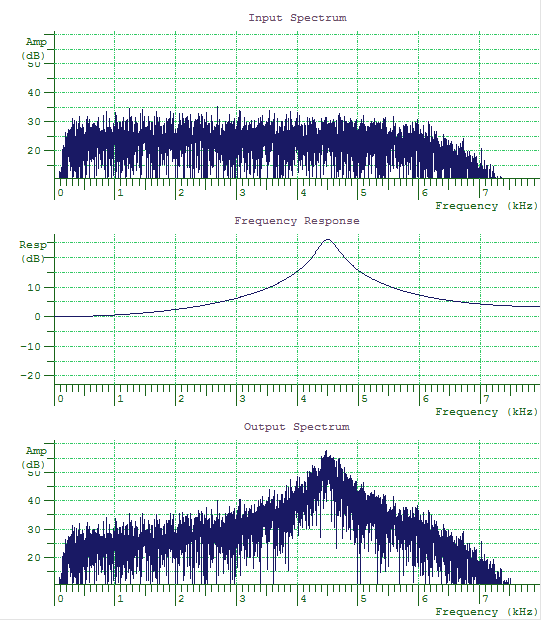6. Consonants
Key Concepts
- Phonological choices can be determined by finding minimal pairs.
- Consonants are described using the Voice-Place-Manner system.
- There are about 24 consonant choices in English which can be classified according to their typical articulation.
- Approximants and Nasals have similar acoustics to vowels.
- The source of energy for fricatives is turbulence generated at or near the constriction. Fricative spectra vary according to size of cavity forward of the constriction.
- Plosives have a series of events: closing, hold, burst, opening, and optional aspiration. Place cues for plosive are related to the spectrum of the burst and the formant transitions.
- Voice Onset Time determines "voicing" for plosives.
Learning Objectives
At the end of this topic the student should be able to:
- describe the procedure by which phonological choices may be identified for a language
- identify the phonological choices for consonants used in English
- describe a typical articulation for each English consonant using the Voice, Place, Manner notational system
- locate vowel articulations and consonantal articulations on spectrograms of simple words
- describe the acoustic differences between English fricatives
- describe the articulatory and acoustic differences between English plosives
Topics
- How to identify phonological choices
To a great extent we can formalise the procedure for finding the phonological choices used in a language by searching for minimal pairs of words - that is, words which only differ by the insertion, substitution or deletion of a single phonological unit. The fact that two words are recognisably different to listeners implies a difference in their phonological form.
Here are some sets of words which help define the English consonant set:
- pin, bin, din, tin, kin, gin, chin
- coat, goat
- sum, sun, sung
- whip, rip, lip, yip
- fin, thin, sin, shin
- vat, that, hat
- baize, beige
- pass, parse
The minimal pair method is not foolproof - for example you can't find a minimal pair which contrasts the /h/ sound in "hat" with the /ŋ/ sound in "sung" (can you see why?). However few people believe these are the "same" phonological unit because they are realised as such different sounds.
- Phonetics of English Consonant Choices
There are about 24 consonant choices used in English words (the number varies according to accent and whether words loaned from other languages are counted). We can use the typical phonetic form of these choices to group the consonants in many ways. Within a typical English accent, the consonant choices can be grouped according to Voice (voiced, voiceless), Place (bilabial, labiodental, dental, alveolar, palatal, velar, glottal) and Manner (plosive, affricate, fricative, nasal, approximant). We can then use symbols from the International Phonetic Association alphabet (IPA chart) to denote these choices and their typical articulation:
Symbol Keyword Place Symbol Keyword Place Voiced Voiceless Plosives b bin Bilabial p pin Bilabial d din Alveolar t tin Alveolar g give Velar k kin Velar Affricates dʒ gin Palato-alveolar tʃ chin Palatal Fricatives v vim Labiodental f fin Labiodental ð this Dental θ thin Dental z zing Alveolar s sin Alveolar ʒ measure Palato-alveolar ʃ shin Palatal h hit Glottal Nasals m mock Bilabial n knock Alveolar ŋ thing Velar Approximants r wrong Alveolar-retroflex l long Alveolar-lateral w wasp Labial-velar j yacht Palatal - Place of Consonant Articulation
In general, the Place of consonant articulation is considered to be the main point of constriction in the vocal tract, where a Primary Active articulator makes contact with or approximates a Passive location.
The names for the main places of articulation are shown in the diagram and table below:

Place Description Bilabial both lips Labiodental lower lip against upper teeth Dental tongue tip against upper teeth Alveolar tongue tip against teeth ridge Alveolar-lateral tongue tip against teeth ridge but with sides lowered Alveolar-retroflex tongue tip curled back near teeth ridge Palato-alveolar tongue tip slightly retracted from teeth ridge Palatal tongue blade against hard palate Velar back of tongue against soft palate Glottal vocal fold closure in larynx - Manner of Consonant Articulation
In general the Manner of consonant articulation describes the nature of the articulatory gesture occurring at one place; in particular it refers to the degree of stricture, that is how closely does the active articulator approach the passive location.
The main manners of articulation are described in the table below:
Manner Description Approximant sounds do not cause complete obstructions of the vocal tract, they are just narrowings of the tract in different ways at different positions. They are all voiced. Plosive sounds have a complete obstruction at some place. These cause an interruption to the air-flow and to the passage of sound from the larynx. For voiceless plosives there is a simultaneous glottal opening gesture as well as an oral closure. Fricative sounds involve a severe narrowing of the air path at some place. The narrowing causes the air flow to become turbulent and to create noise. In voiced fricatives, this turbulent noise is added to the sound of phonation from the larynx. Affricate sounds are like a combination of plosive and fricative: a plosive like oral closure followed by a fricative release. Nasal sounds have oral closures like the plosives, but these are made in combination with a lowered soft palate that allows air flow out through the nose. The continuation of flow means that voicing can be maintained. - Voicing of Consonant Articulation
In general the Voice of consonants relates to the form of any associated laryngeal configuration or gesture. Approximants and Nasals are always voiced - that is, they are always associated with a closed glottis and phonation. Fricatives fall into two categories. Unvoiced ("voiceless") fricatives are made with an open glottis, so that the only sound being generated is that of the turbulence at the place of constriction. Voiced fricatives are made with a closed glottis - this can lead to two simultaneous sources of sound: both phonation in the larynx and turbulence at the place of constriction. See diagram below.
The situation in Plosives is more complex. In a Voiced plosive made between two vowel sounds, the glottis typically remains closed throughout. However, this does not mean that phonation occurs through the consonant. Because a plosive creates a complete obstruction to the air flow in the oral cavity, it prevents air flowing through the larynx and hence prevents phonation. Thus in a voiced plosive phonation tends to stop soon after the oral closure is made and does not restart until the closure is removed and air can flow again through the larynx. Typically voicing will restart very quickly after release of the plosive - within 30ms. See diagram below.
When Unvoiced plosives are made between two vowel sounds, a laryngeal gesture occurs in which the vocal folds are fully or partially abducted (pulled apart) thereby opening the glottis. The glottis opening gesture is made simultaneously with the oral closure of the plosive. This tends to make phonation stop more rapidly than in the voiced case. When the plosive is released, the glottis may still be open or only partially closed. This means that voicing does not restart at plosive release. Instead, the air flow that builds up through the larynx may cause turbulence - creating a kind of /h/ sound that immediately follows the plosive burst. This glottal turbulence following the release of an unvoiced plosive is called aspiration. Finally, some time after the release, a second glottal gesture takes place in which the folds become fully approximated, the glottis closes and phonation restarts. However this restart occurs some time after the plosive release, typically more than 30ms later. See diagram below.

- Consonant Acoustics
We can apply the source-filter model to consonant acoustics as well as to vowels. In voiced sounds one sound source is larynx vibration. In voiceless sounds the sound source is turbulence created at a constriction in the vocal tract. The filter is often considered to be just the effect of the vocal tract pipe forward of the sound source. For example in fricatives, the filter is the part of the vocal tract tube that extends from the point of constriction to the lips, while in nasals the filter includes the effect of resonances of the nasal cavity.
Approximants
Since approximants do not have a complete closure in the oral cavity, we can analyze their acoustics using the methods developed for vowels and diphthongs, that is in terms of changes in the frequencies of the resonances of the vocal tract as it changes shape. Approximants are thus seen as particularly shaped movements of the formant pattern with time:
Nasals
Although nasals do have an oral closure, the lowered soft palate ensures a continuation of airflow through the larynx and continued phonation. The resonances of the nasal cavity affect the timbre of larynx buzz in much the same way as the resonances of the oral cavity (aka formants) affect the timbre of larynx buzz in vowels. Although in nasals sound does not pass through the oral cavity, the shape of the oral cavity behind the closure does contribute to the overall frequency response of the vocal tract pipe and hence to the spectral pattern observed on a spectrogram:
Fricatives
Since fricatives have a narrow constriction, the cavity behind the constriction does not play a very large role in shaping the frequency response of the filter (since sound is strongly attenuated passing from behind the constriction to the front). The frequency response of the front cavity is strongly affected by its length and size of opening. This is why energy is concentrated at higher frequencies the more the place of articulation moves to the front of the mouth.
We can explain fricative acoustics using the source-filter model. The source is turbulence generated at the point of constriction which has a generally flat spectrum. The filter is the effect of the anterior cavity, which has a few resonances. In the simulation below we see a noise spectrum being shaped by a single wide resonance at about 2500Hz, which gives a [ʃ]-like sound, and at about 4500Hz, which gives a [s]-like sound:


You can see the effect of changing size of anterior cavity on the spectrograms of fricatives.
Plosives
To understand the acoustics of plosives, it is necessary to divide their articulation into separate phases: a closing phase, a hold phase, a release phase and an optional aspiration phase. In the closing phase we see the previous vowel cut off as the oral closure is made. In the hold phase we see a silent interval in the sound (the "stop gap"). In the release phase we may see a short interval of turbulence made at the point of constriction as the articulator comes away from the closure (the "burst"). The sound of this turbulence will be shaped by the cavity forward of the closure, just as in fricatives. Finally, in the aspiration phase found in voiceless plosives, turbulence occurs at the glottis, producing a kind of /h/ sound.
Readings
Essential
- Hewlett and Beck, Introduction to the Science of Phonetics, Chapter 4, Basic principles of consonant description. [available in library].
Background
- Elizabeth Zsiga, "The Sounds of Language", Wiley Blackwell 2013. Chapter 3 - A Tour of the Consonants. [available in library]
- Peter Ladefoged, "Vowels and Consonants", Blackwell 2001. Chapter 6, The sounds of consonants. [available in library]
Laboratory Activities
In this week's lab session you will look at the spectrographic character of consonants in context.
- Studying the essential character of approximants, nasals, fricatives and plosives in some minimal pairs
- Studying how fricatives change with place and voice within a recording of the sentence: "The freezing harsh and heaving seas".
Reflections
You can improve your learning by reflecting on your understanding. Come to the tutorial prepared to discuss the items below.
- What happens to /t/ when we change only its Voicing? Its Place? Its Manner?
- What makes /w/ and /j/ different from /u/ and /i/?
- Generally, how do fricative sounds change as the place of articulation is brought forward in the mouth?
- Think of two ways in which losing your two front upper teeth will affect fricative production.
- How and why does lip-rounding affect fricative quality?
- What might cause a voiced fricative to lose its voicing? What might cause a voiced fricative to lose its turbulence?
Word count: . Last modified: 14:26 17-Feb-2021.
